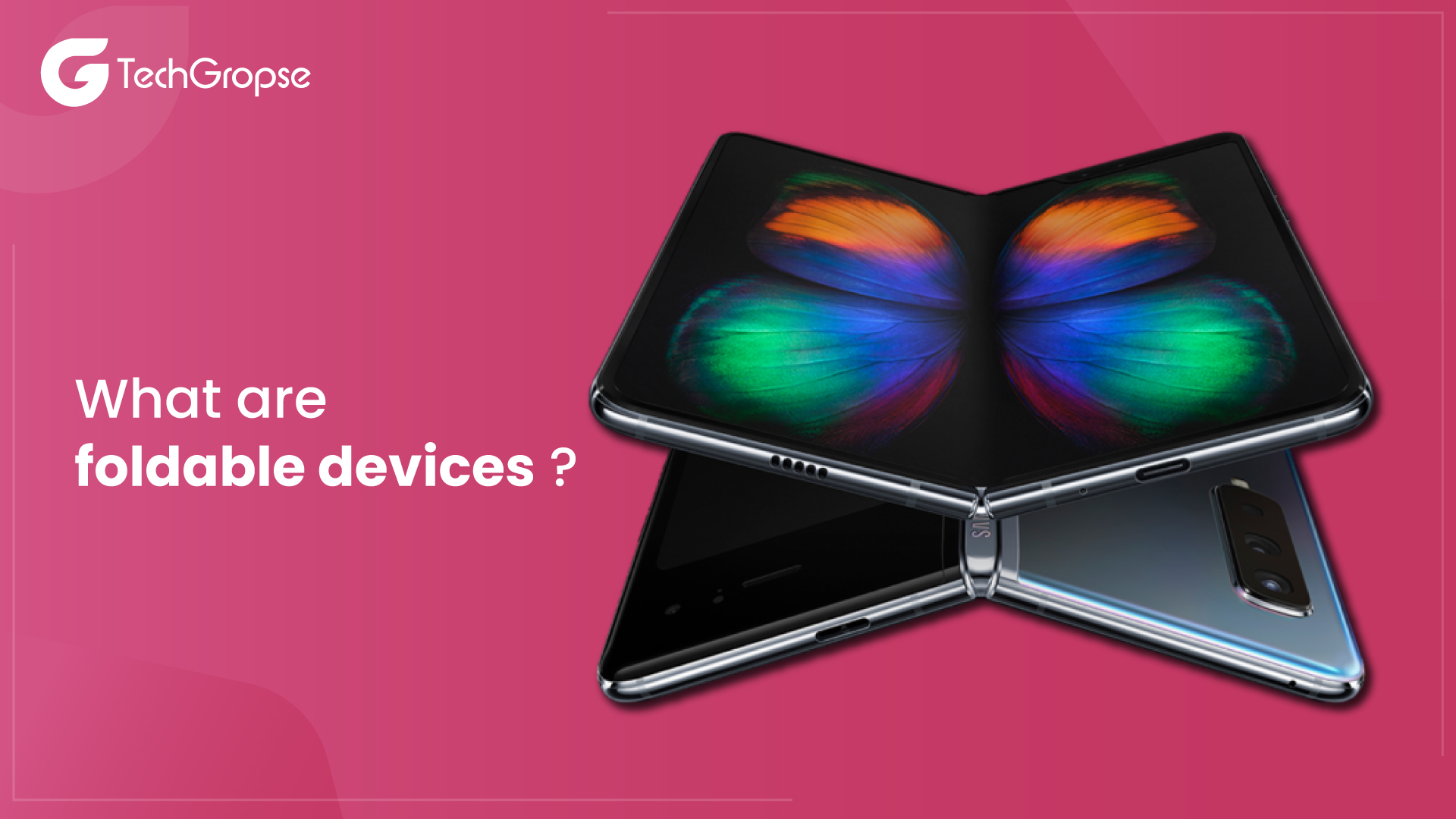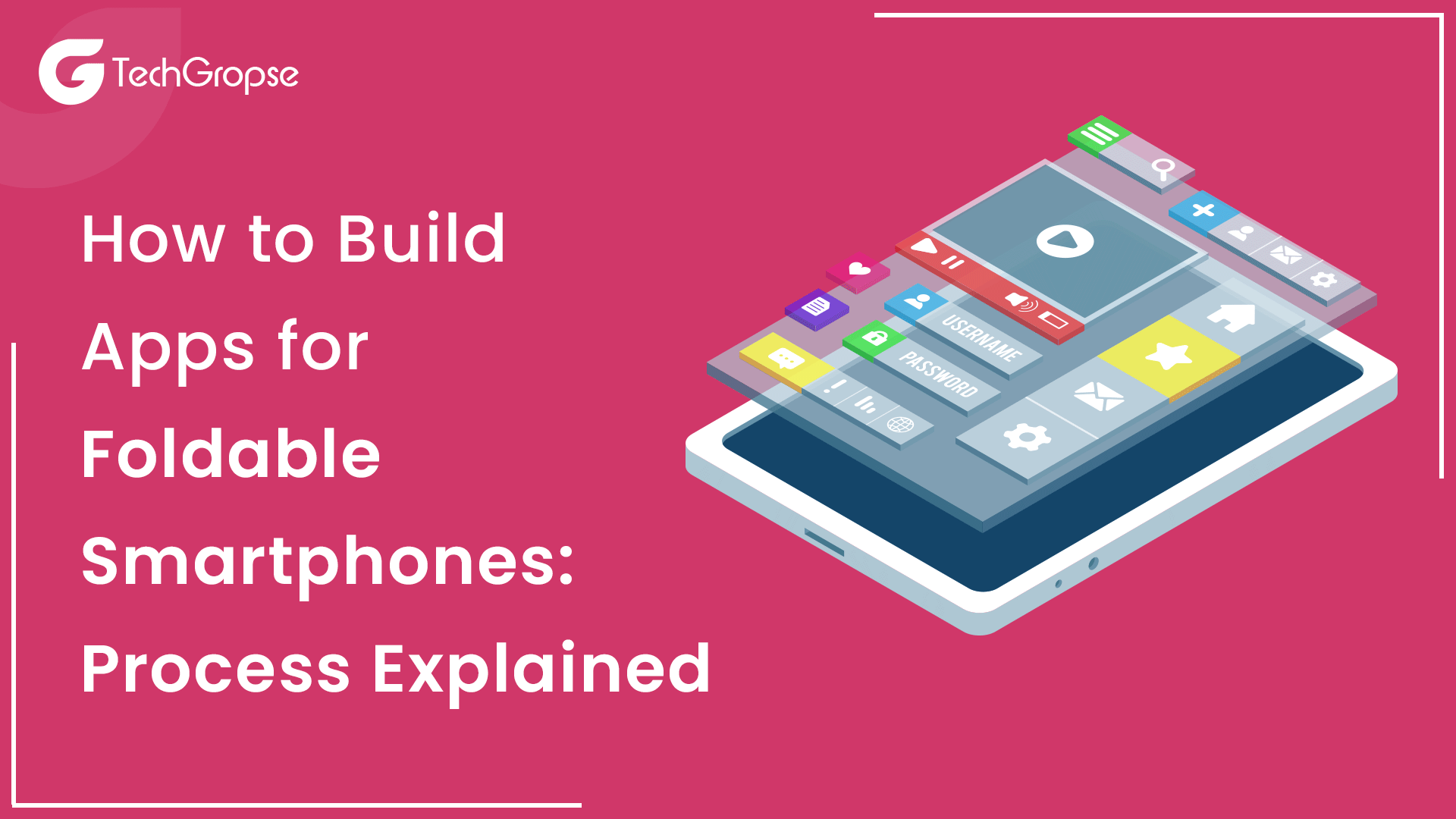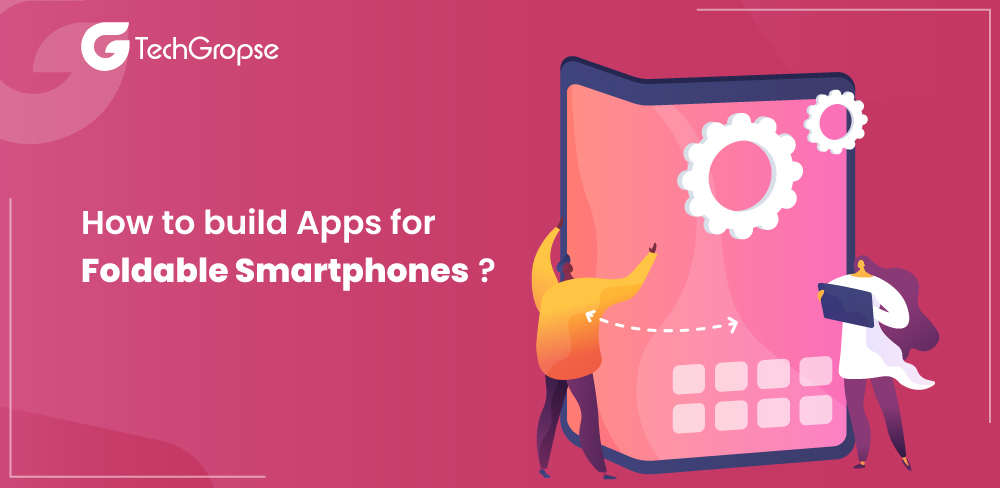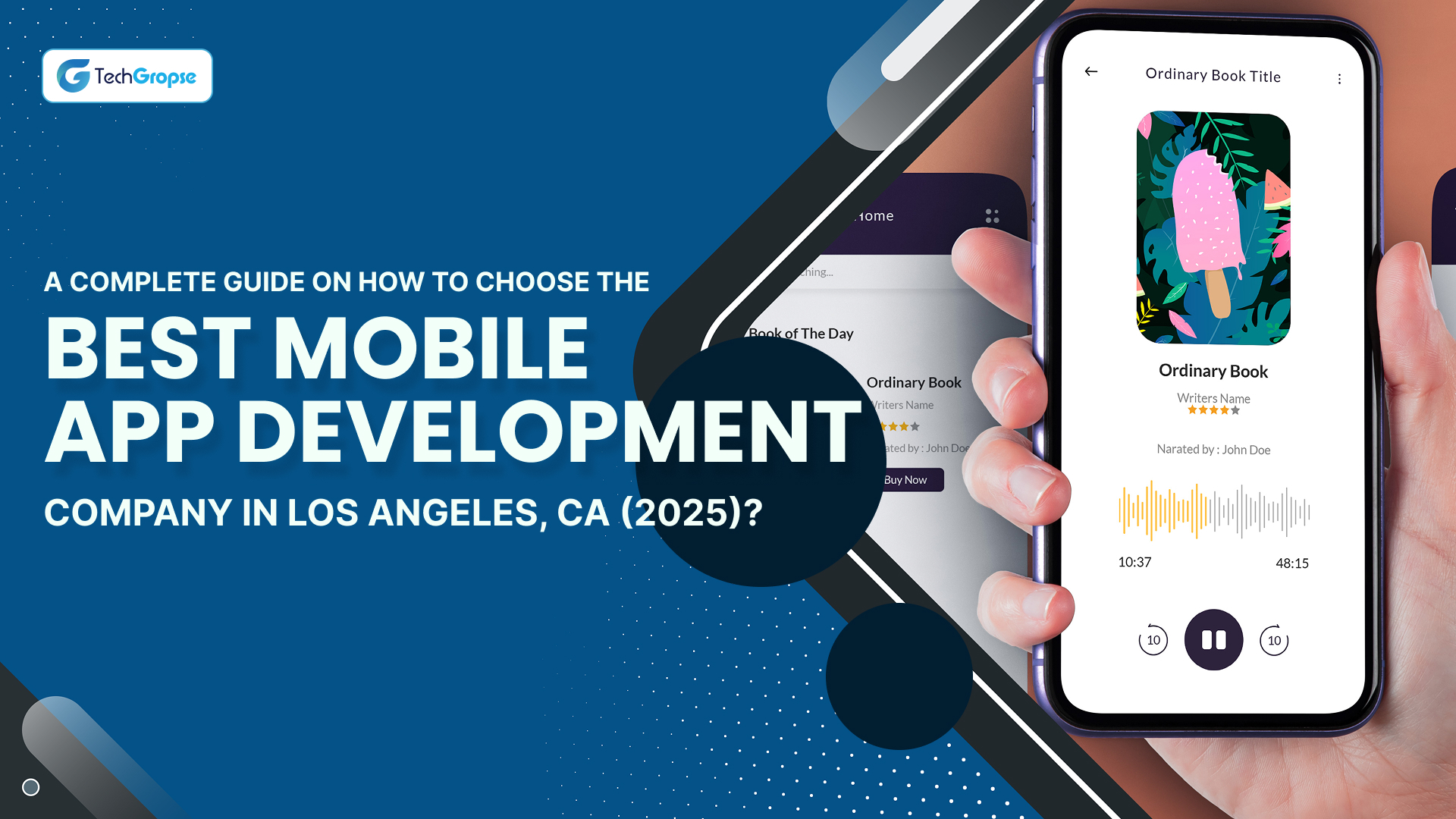Foldable and flip smartphones were once the new black and now they are back in trend once again. The launch of Galaxy Z fold reshaped the market and switched the focus on foldable smartphones once again. Now that they are back in the picture, as an entrepreneur you should totally not ignore the marketplace of it.
Is it conceivable that foldable technology could make existing smartphones outdated? The extent to which they are functional determines everything. Time will reveal. For the time being, we will observe how things grow and consider how we can embrace the trend by creating apps for foldable devices. In this blog we will talk about how to build Apps for Foldable Smartphones.
What are Foldable Devices?

It’s a fantastic moment to find your specs and start researching the new technologies underlying Android foldables if you want to stay on top of the most recent trends and advancements. The phrase “foldable device” first appeared in 2008 when Nokia unveiled the Morph idea. The ability to fold flexible OLED panels into double-size full-screen displays is what makes them special.
Users benefit from a better, more immersive experience thanks to foldable technology. The Samsung Galaxy Fold, which is now for sale, is now the knight in shining armor of foldable devices. . The technology is likely to gain more traction among makers of smartphones and tablets. Stating facts by statista- 75,6 million foldable smartphone screens will be sold by 2025. So, it’s time for you to know how to build Apps for Foldable Smartphones.
Want to learn more about to Build Apps for Foldable Smartphones in atlanta? Check out: mobile app development
What Technicalities Do You Need to Keep in Mind for Foldable Devices?
Here are some factors you need to consider while you’re learning to build Apps for Foldable Smartphones.
Screen Mode
The two main screens—Folded and Unfolded—must be taken into account while creating mobile apps for foldable smartphones. Talking about the primary display of a smartphone is its folded screen, whereas the regular display is its unfurled screen.
Due to the device’s changing size, the user experience differs in both screen modes. The majority of the time, people use their cell phones in their normal condition, however some functions, such as streaming films and playing games, compels them to use their phones in an unfolded position.
App- Screen Continuity
When switched to the appropriate screen size on foldable devices, an app should be easily modified to the size. Developers of mobile apps must consider how the app will transition when a user changes from folded to unfolded mode.
The user experience shouldn’t be compromised by the app’s functionality. When the user folds or unfolds the mobile device, it should continue in the same condition. As a result, the app should support the modification without changing anything in the layout in order to preserve the UI state.
Multi-Window Feature
The development of foldable smartphone technology has made it feasible to use many windows simultaneously. In the past, operating just one window while pausing the others was the plan. Multiple windows can now be controlled simultaneously when they are all in the resume/active state. To make your app optimal for usage in a foldable smartphone you must hire android app developers that are experienced in developing multi-window features.
Need nearshore more details about to Build Apps for Foldable Smartphones in chicago? Explore mobile app development
Screen Ratio
When creating apps for foldable devices, developers must take the newest Android releases into account. A broad variety of screen ratios are supported by mobile devices running Android versions 10 and higher. As a result, screen ratios ranging from 1:1 to 21:1, 21:9, and beyond must be tested by mobile app developers.
This would make it easier for the app to adjust to different screen sizes without interfering with a smooth user experience. Making the app suitable with as many screen kinds on the market as possible is the ultimate purpose of testing it for different screen sizes.
>>> Read More : 10 Questions Startups Need to Answer Before Building An App <<<
Challenges Faced while Developing Foldable Devices

Make sure you are aware of the obstacles you will face before starting to create an app for foldable devices. This is an important factor in knowing how to build Apps for Foldable Smartphones. In order to create a top-notch and user-friendly foldable application, you must consider the following factors:
Want to learn more about to Build Apps for Foldable Smartphones in san francisco? Check out: mobile app development
High User Expectations
Nobody is claiming that creating apps for foldable technology is simple or painless. You should be aware that foldable phones must support many orientations and differ from conventional smartphones in terms of aspect ratio.
But user expectations continue to be the same. They want to use your app without experiencing any bugs. Therefore, you must hire mobile app developers that know how to build Apps for Foldable Smartphones; else, your app will fail.
Lengthier Testing
Numerous use cases and scenarios are offered by foldable solutions. You must test every feature and every usage case to ensure that there won’t be any problems lurking in the background. More money and time will be spent on QA and testing the multi-window app so that it comes out flawless.
Increased Development Time and Cost
You will be bringing your solution into a new realm if you choose to create an app for a foldable device or make an existing one viable. Your app has to be designed, developed, and tested for a variety of modes and use cases. More work also means more money out of pocket and more time required for the development phase.
Screen Ratio
When creating apps for foldable devices, developers must take the newest Android releases into account. A broad variety of screen ratios are supported by mobile devices running Android versions 10 and higher. As a result, screen ratios ranging from 1:1 to 21:1, 21:9, and beyond must be tested by mobile app developers in Saudi.
This would make it easier for the app to adjust to different screen sizes without interfering with a smooth user experience. Making the app suitable with as many screen kinds on the market as possible is the ultimate purpose of testing it for different screen sizes.
Need nearshore more details about to Build Apps for Foldable Smartphones in los angeles? Explore mobile app development
How to Build Apps for Foldable Smartphones?
If you wish to know how to build Apps for Foldable Smartphones, you must first carefully understand the main stages of app development
The process is often divided into two parts by the businesses: discovery and development.
Discovery Phase
The discovery stage enables you to avoid spending time and money on future revamps and is a key factor to the success of your foldable application.
If you collaborate with a mobile application development company in Dubai, they will evaluate your objectives, technical requirements, and how the team will approach the development process during the discovery stage.
The discovery stage includes following deliverables:
- Market analysis
- Competitor analysis
- Functional specifications
- Product backlog
The exploration phase includes a sizable part for UX/UI design. You should develop the user interface’s logic and consider how people will interact with it in terms of visual aspects of the UI.
In the discovery stage of UI/UX includes following deliverables:
- UX wireframes
- UI mockups
- Branding elements
- Illustrations and animations
Development Stage
The development stage is where your application’s coding and construction take place. You must now identify the entire list of upcoming activities, develop project requirements, and establish an implementation schedule.
Typically, there are three phases of development:
- Coding involves writing the code framework for your next app and integrating it with third-party APIs and other solutions.
- QA and testing are crucial steps in developing mobile apps that guarantee functionality is implemented in accordance with specifications. This stage often includes various testing and quality assurance procedures depending on the type of application.
- Deployment, Ongoing Development & Support — After the app is made available to the public, you will still need to work on it. Regular maintenance and upgrades will benefit it and will also surprise your users with new updates and bug fixes.
Want to learn more about to Build Apps for Foldable Smartphones in New York? Check out: mobile app development
Build Apps for Foldables: Step by Step Guide

Although creating an app for a foldable smartphone might take some time, developers must complete every stage of the process. Here is a brief overview on the development of foldable mobile apps.
1. Market Analysis and Competitor Research
Before entering the competition, market research is vital. It will assist in locating information on issues like possible rivals, the target market, the goal of the app, and its USP.
2. App Concept
You’ll have a good understanding of the app’s idea once you’ve looked for solutions to the concerns in the earlier stage. It will assist you with determining how users will interact with the app and what features need to be included to provide a smooth user experience.
3. App Monetization
Once you choose the monetization strategy, your app for foldable devices will start to make money. Mobile apps generally make profit via a variety of methods. In-app purchases, subscriptions, adverts, and partnerships are some of the ways in which you can monetize your app.
4. UI/UX Designing
UI/UX Designing When creating an app, all features should be scaled to avoid the pitfalls. Therefore, designers must take care that they use the potential of increased screen space to its fullest.
5. Marketing Techniques
Never overlook an app’s marketing, particularly if it is a new player on the market. It is important to properly advertise the app since the launching plan is just as significant as the on-demand app development approach.
There are various ways in which you can monetize an app, these include promotions on various channels such as paid marketing, content marketing and much more.
Need nearshore more details about to Build Apps for Foldable Smartphones in Houston? Explore mobile app development
Conclusion
The latest generation of foldable smartphones is back and is now stronger than ever. Based on its operating system, battery life, back cameras, and reliable performance, Samsung foldables on the market, such as the Samsung Galaxy Z fold series and Samsung Galaxy Z flip series, have already garnered praise. Since Samsung is now the “Czar of Foldables,” it is the ideal case study to draw inspiration from in terms of both uses and aesthetics. So while you’re out there developing your very own foldable smartphone, be sure to study it.
There will be a rapid spike of foldable cellphones in the near future. Global shipments of foldable smartphones are expected to climb by 1.5% by 2025, according to calculations.
You learned about the essential elements needed to build Apps for Foldable Smartphones. If you follow this guide and partner with a leading custom mobile application development company, your foldable smartphone app development will be a cakewalk.
Building apps for foldable smartphones requires innovative approaches, and leveraging Android app development solutions in Atlanta can help you create adaptable and user-friendly experiences.










